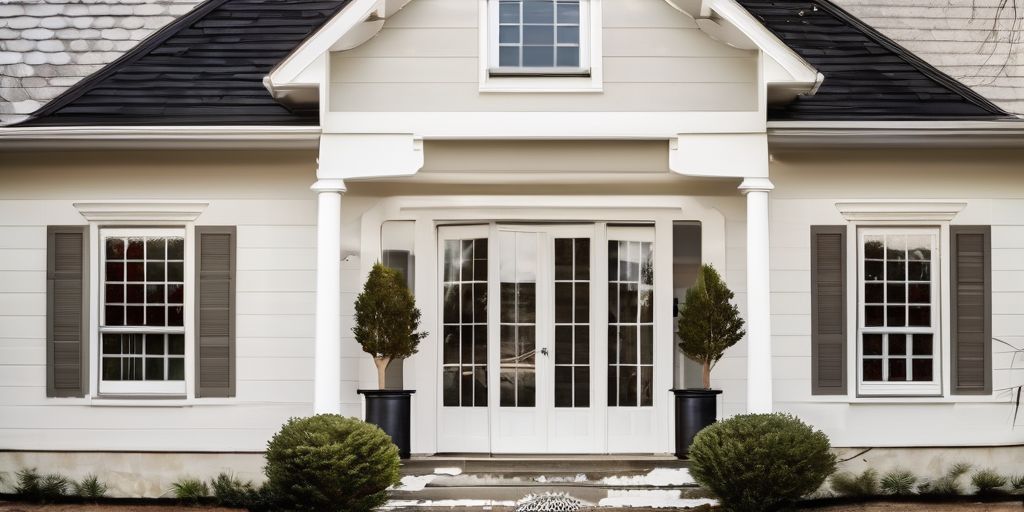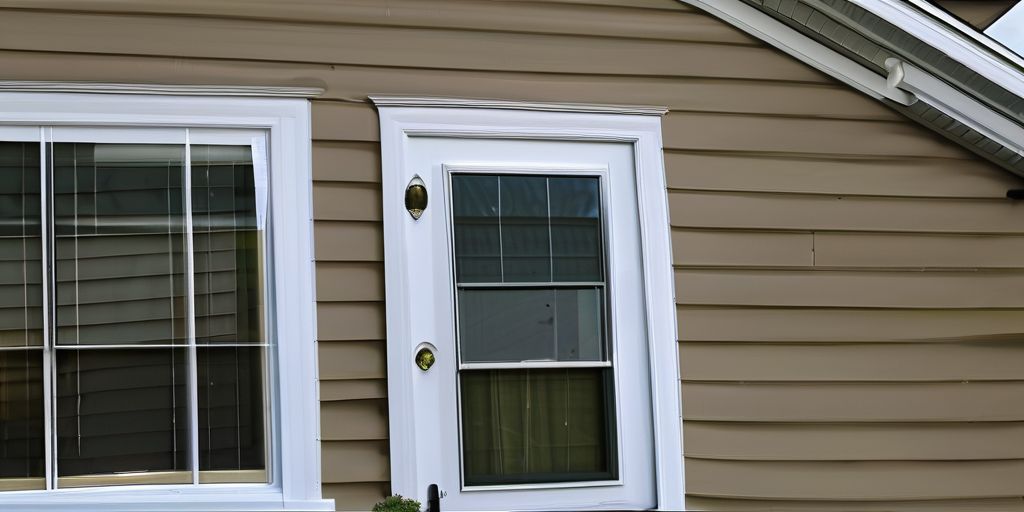Painting vinyl siding can change the look of your home and make it last longer. But, if you live in Cambridge, you need to think about the humidity. This article will help you understand how humidity affects painting vinyl siding and give you tips on how to get the best results.
Key Takeaways
- Humidity can make paint not stick well to vinyl siding.
- The best humidity level for painting is between 40% and 50%.
- Using acrylic paint can help your paint job last longer.
- Cleaning and fixing your siding before painting is very important.
- Think about the weather in Cambridge before you start painting.
Understanding the Role of Humidity in Vinyl Siding Painting
How Humidity Affects Paint Adhesion
Humidity can greatly impact how well paint sticks to vinyl siding. When the air is too humid, the paint may not dry properly, leading to issues like bubbling and peeling. Proper preparation is essential to manage these effects. Make sure to clean and dry the siding thoroughly before painting.
Ideal Humidity Levels for Painting
For the best results, aim to paint when the humidity is between 40% and 50%. This range allows the paint to dry evenly and adhere well. Avoid painting on days when the humidity is very high or very low. Mild weather conditions are ideal for painting projects.
Common Mistakes to Avoid
- Painting in direct sunlight or when rain is expected.
- Not cleaning the siding properly before painting.
- Using low-quality paint that can’t withstand humid conditions.
- Ignoring weather forecasts and local climate factors.
Remember, the goal is not to rush the job but to ensure a durable and long-lasting finish. Proper preparation and timing are key to managing humidity effects on vinyl siding painting in Cambridge.
Choosing the Right Paint for Vinyl Siding
Benefits of Acrylic Paint
Acrylic paint is a top choice for vinyl siding due to its excellent adhesion and flexibility. This type of paint can withstand temperature changes without cracking, making it ideal for the varying weather conditions in Cambridge. High-quality acrylic paint also resists fading, chalking, and peeling, ensuring your siding looks vibrant for years.
Color Selection Tips
Choosing the right color for your vinyl siding can be a fun yet challenging task. Here are some tips to help you decide:
- Consider the architectural style of your home.
- Think about the surrounding landscape and neighborhood.
- Test a few samples in different lighting conditions.
Remember, lighter colors can make your home appear larger, while darker shades can add a touch of elegance.
Tools for a Smooth Application
Using the right tools is crucial for a smooth and even paint application. Here are some essentials:
- Brushes and rollers for edges and small areas.
- Paint sprayers for large surfaces.
- Drop cloths and painter’s tape to protect areas you don’t want to paint.
Proper preparation and the right tools can make a significant difference in the outcome of your painting project. Take your time to ensure everything is set up correctly before you start.
By following these guidelines, you can achieve a professional-looking paint job that enhances your home’s curb appeal and protects your vinyl siding from the elements.
Preparing Your Vinyl Siding for Painting
Cleaning and Repairing Siding
Before you start painting, it’s important to clean your vinyl siding thoroughly. This helps remove dirt, grime, and mildew that can affect paint adhesion. Follow these steps:
- Mix water with a gentle cleaning solution.
- Use a soft brush or cloth to scrub the siding.
- Rinse with clean water and let it dry completely.
If you find any damaged areas, repair them before painting. Sand and paint the siding to ensure a smooth surface.
Remember, the goal is not to cover the siding in the least amount of time but to build up a protective coating that enhances the siding’s longevity and aesthetic appeal.
Priming for Better Results
Applying a primer is essential for a lasting paint job. Vinyl siding is non-porous, so a primer helps the paint stick better. Here’s how to do it:
- Choose a high-quality primer designed for vinyl.
- Pour primer into a paint tray.
- Use a roller to apply primer evenly, avoiding heavy coats that can cause drips.
Weather Considerations
Timing your painting project is crucial. Consider weather conditions to ensure the best results. Here are some tips:
- Avoid painting on extremely hot or cold days.
- Check the forecast to ensure dry weather for at least 24 hours.
- Early fall or late spring are often the best times to paint in Cambridge.
By following these steps, you’ll be well on your way to a successful vinyl siding painting project.
DIY vs. Professional Painting: Making the Right Choice
Pros and Cons of DIY Painting
Taking on a DIY painting project can be both rewarding and challenging. Here are some pros and cons to consider:
Pros:
- Cost Savings: DIY painting can save you money on labor costs.
- Personal Satisfaction: Completing a project yourself can be very satisfying.
- Flexibility: You can work on your own schedule.
Cons:
- Time-Consuming: Painting can take a lot of time, especially for larger homes.
- Skill Level: Achieving a professional finish requires skill and experience.
- Equipment Costs: You may need to buy or rent specialized tools.
When to Hire a Professional
Hiring a professional painter can be a wise choice in many situations. Consider hiring a pro if:
- You have a large or complex project.
- You lack the time or skills to do the job yourself.
- You want a high-quality finish that will last.
- Your home has intricate trim or multiple stories.
Cost Considerations
The cost of painting your vinyl siding can vary widely. Here are some factors that can affect the price:
- Size of Home: Larger homes require more materials and labor.
- Complexity: Features like intricate trim work or multiple stories can add to the cost.
- Materials: High-quality paints and primers may have a higher upfront cost but can lead to longer-lasting results.
Remember, while DIY painting can be a rewarding project, professional painting services are available for those seeking a fresh, modern look without the hassle.
In Cambridge, where historic architecture often requires special care, finding a skilled professional with experience in the area can be particularly valuable.
Maintaining Your Painted Vinyl Siding
Routine Maintenance Tips
To keep your painted vinyl siding looking fresh, regular cleaning is essential. Dirt, grime, and mildew can build up over time, leading to discoloration. Regular maintenance not only keeps your siding looking great but also prevents substances that can shorten the paint’s durability. Here are some steps to follow:
- Use a soft brush or cloth to clean the siding.
- Avoid harsh chemicals or abrasive tools.
- Schedule routine cleanings to maintain the siding’s appearance.
Remember, harsh chemicals or abrasive tools can damage both the paint and the siding material. It’s crucial to use the right products and techniques to maintain the integrity of your painted vinyl siding.
Handling Peeling and Cracking
Peeling and cracking can occur due to various factors, including weather conditions. Inspect your siding regularly for any signs of damage. If you notice peeling or cracking, take these steps:
- Clean the affected area thoroughly.
- Sand the edges of the peeling paint to smooth them out.
- Apply a primer before repainting the area.
- Use high-quality paint to ensure better adhesion and durability.
Repainting Guidelines
Repainting your vinyl siding can refresh its look and extend its life. Follow these guidelines for the best results:
- Choose a day with mild weather to avoid issues with paint adhesion.
- Ensure the siding is clean and dry before starting.
- Apply paint in thin, even coats to avoid drips and uneven coverage.
- Allow sufficient drying time between coats.
By following these tips, you can keep your painted vinyl siding in excellent condition for years to come.
Seasonal Tips for Painting Vinyl Siding in Cambridge
Best Times of Year to Paint
Painting your vinyl siding in Cambridge requires careful timing. The best seasons to paint are spring and fall. During these times, the weather is mild, and humidity levels are more stable. Avoid painting in extreme temperatures as it can affect the paint’s adhesion and drying time. Here are some tips:
- Aim for temperatures between 50°F and 85°F.
- Check the weather forecast to ensure no rain is expected for at least 24 hours.
- Avoid painting in direct sunlight to prevent the paint from drying too quickly.
Dealing with Cambridge’s Climate
Cambridge’s climate can be unpredictable, with sudden changes in weather. This can pose challenges for exterior painters. To manage this:
- Monitor humidity levels, aiming for a range of 40% to 70%.
- Be prepared to pause your project if unexpected weather conditions arise.
- Consider using weather-resistant paint to withstand Cambridge’s varying climate.
Long-Term Weather Impact
The long-term impact of Cambridge’s weather on your painted vinyl siding is significant. Seasonal changes, including humidity and temperature fluctuations, can affect the longevity of your paint job. To ensure durability:
- Use high-quality acrylic paint designed for vinyl siding.
- Apply multiple thin coats rather than one thick coat.
- Regularly inspect your siding for signs of wear and tear.
Maintaining painted vinyl siding in high humidity and seasonal changes is crucial for longevity. Protective coatings can help, and knowing when to repaint is essential.
By following these tips, you can achieve a beautiful and long-lasting finish on your vinyl siding, even in Cambridge’s challenging climate.
Common Challenges and Solutions in Vinyl Siding Painting
Addressing Paint Bubbling
Paint bubbling is a common issue when painting vinyl siding. This happens when moisture gets trapped under the paint layer. To prevent this, ensure your siding is completely dry before painting. Proper preparation is key. Here are some steps to follow:
- Clean the siding thoroughly to remove dirt and mildew.
- Sand the surface lightly to create a better grip for the paint.
- Apply a high-quality primer before painting.
Preventing Mold and Mildew
Mold and mildew can ruin the look of your painted siding and cause health issues. To keep these problems at bay:
- Use a mold-resistant paint.
- Clean the siding regularly, especially in shaded areas where mold is more likely to grow.
- Ensure proper ventilation around your home to reduce moisture buildup.
Ensuring Even Coverage
Achieving even coverage can be tricky, especially on textured vinyl siding. Here are some tips to help:
- Use a paint sprayer for large areas to get a smooth, even coat.
- Apply multiple thin coats rather than one thick coat.
- Pay attention to the weather; avoid painting on very humid or windy days.
Remember, the goal is not to cover the siding in the least amount of time but to build up a protective coating that enhances the siding’s longevity and aesthetic appeal.
Painting vinyl siding can be tricky, but with the right approach, it can look amazing. Common issues include peeling paint and poor adhesion, but these can be fixed with proper preparation and high-quality products. If you’re facing these challenges, visit our website to learn more about our expert solutions and get a free estimate today!
Conclusion
Painting vinyl siding in Cambridge can be a rewarding project if done correctly. The key is to pay attention to the weather, especially humidity, as it plays a big role in how the paint dries and sticks to the siding. Make sure to prepare the surface well, use high-quality paint, and apply it carefully. If the job seems too big or complicated, don’t hesitate to call in professional painters. They have the experience and tools to ensure a beautiful and long-lasting finish. With the right approach, your home can look fresh and new for years to come.
Frequently Asked Questions
What are some tips for applying paint to vinyl siding?
Use a good quality acrylic paint made for vinyl. Start with a brush or roller for edges and smaller areas, then use a sprayer for large, even coverage. Apply several thin coats instead of one thick coat.
When should I consider hiring professional painters for my vinyl siding project in Cambridge?
If you want a high-quality finish, aren’t comfortable with DIY, or have a big or complex project, hiring professional painters with experience in vinyl siding is a smart choice.
How does humidity affect painting vinyl siding?
Humidity can make it hard for paint to stick well and dry properly. It’s best to paint on days with mild weather to help the paint cure right.
What is the best time of year to paint vinyl siding in Cambridge?
The best times to paint are during mild weather, usually in late spring or early fall. Avoid painting in extreme heat or cold.
How do I prepare my vinyl siding for painting?
Clean and repair the siding first. Then apply a primer before painting. Make sure to choose high-quality tools and consider the weather for the best results.
What should I do if the paint on my vinyl siding starts to peel or crack?
If the paint starts to peel or crack, you should clean the area and sand it lightly. Then, apply a primer and repaint the area with a matching color.





